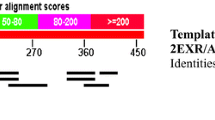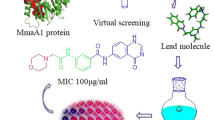Abstract
Inhibition of protein–protein interaction is considered as an innovative approach in the drug development field. In the present study, this strategy has been handled computationally using in-silico tools to identify potential leads against M. tuberculosis, a still undefeatable pathogen. CarD, a translational regulator protein seems to be indispensible for the survival and pathogenicity of M. tuberculosis. Many mutational studies have recommended that inhibition of its interaction with RNA polymerase using small molecules would be a promising therapy against tuberculosis. Hence in this study, using CarD–RNA polymerase complex structure, hotspot residues which favor complex formation were identified with BioLuminate program and Anchor tool. Based on this information, peptide similarity search was carried out by pepMMsMIMIC tool in MMsINC database and virtual screening was done against ZINC database molecules using DOCK Blaster tool. The small molecule hits from both the studies were collected to create a library. Docking studies were carried out with the library molecules against CarD using Glide program and eight molecules were identified as potential hits. Of them, molecules MMs02420750, MMs02489191 and MMs02514414 were found to interact with the important hotspot residues of CarD and thereby are considered to be capable of inhibiting CarD–RNA polymerase complex formation. The binding free energies of the Glide hit complexes were calculated by MM/GBSA approach and molecule MMs02420750 was identified to have more affinity towards CarD and hence taken for molecular dynamics simulation studies to check the stability of the complex. Finally, the ADME profile of this small molecule hit was predicted by QikProp program. This small molecule ligand which interacts with hot spots on CarD to form a stable complex may inhibit CarD from interacting with RNA polymerase and hence can be considered as an initial lead for the development of novel anti-tuberculosis agents.







Similar content being viewed by others
References
Beard H, Cholleti A, Pearlman D et al (2013) Applying physics-based scoring to calculate free energies of binding for single amino acid mutations in protein-protein complexes. PLoS ONE 8:e82849. https://doi.org/10.1371/journal.pone.0082849
Dhanavade M, Jalkute C, Barage S, Sonawane K (2013) Homology modeling, molecular docking and MD simulation studies to investigate role of cysteine protease from Xanthomonas campestris in degradation of Aβ peptide. Comput Biol Med 43(12):2063–2070. https://doi.org/10.1016/j.compbiomed.2013.09.021.853-1866.
Essmann U, Perera L, Berkowitz M et al (1995) A smooth particle mesh Ewald method. J Chem Phys 103:8577–8593. https://doi.org/10.1063/1.470117
Floris M, Masciocchi J, Fanton M, Moro S (2011) Swimming into peptidomimetic chemical space using pepMMsMIMIC. Nucl Acids Res 39:W261–W269. https://doi.org/10.1093/nar/gkr287
Friesner R, Banks J, Murphy R et al (2004) Glide: a new approach for rapid, accurate docking and scoring. 1. Method and assessment of docking accuracy. J Med Chem 47:1739–1749. https://doi.org/10.1021/jm0306430
Friesner R, Murphy R, Repasky M et al (2006) Extra precision glide: docking and scoring incorporating a model of hydrophobic enclosure for protein–ligand complexes. J Med Chem 49:6177–6196. https://doi.org/10.1021/jm051256o
Guex N, Peitsch M, Schwede T (2009) Automated comparative protein structure modeling with SWISS-MODEL and Swiss-PdbViewer: a historical perspective. Electrophoresis 30:S162–S173. https://doi.org/10.1002/elps.200900140
Gulten G, Sacchettini J (2013) Structure of the Mtb CarD/RNAP β-lobes complex reveals the molecular basis of interaction and presents a distinct DNA-binding domain for Mtb CarD. Structure 21:1859–1869. https://doi.org/10.1016/j.str.2013.08.014
Halgren T, Murphy R, Friesner R et al (2004) Glide: a new approach for rapid, accurate docking and scoring. 2. Enrichment factors in database screening. J Med Chem 47:1750–1759. https://doi.org/10.1021/jm030644s
Hess B, Bekker H, Berendsen H, Fraaije J (1997) LINCS: a linear constraint solver for molecular simulations. J Comput Chem 18:1463–1472.
Irwin J, Shoichet B, Mysinger M et al (2009) Automated docking screens: a feasibility study. J Med Chem 52:5712–5720. https://doi.org/10.1021/jm9006966
Irwin J, Sterling T, Mysinger M et al (2012) ZINC: a free tool to discover chemistry for biology. J Chem Inf Model 52:1757–1768. https://doi.org/10.1021/ci3001277
Jalkute C, Barage S, Dhanavade M, Sonawane K (2013) Molecular dynamics simulation and molecular docking studies of angiotensin converting enzyme with inhibitor lisinopril and amyloid beta peptide. Protein J 32:356–364. https://doi.org/10.1007/s10930-013-9492-3
Jalkute C, Barage S, Dhanavade M, Sonawane K (2014) Identification of angiotensin converting enzyme inhibitor: an in silico perspective. Int J Pept Res Ther 21:107–115. https://doi.org/10.1007/s10989-014-9434-8
Kabsch W, Sander C (1983) Dictionary of protein secondary structure: pattern recognition of hydrogen-bonded and geometrical features. Biopolymers 22:2577–2637. https://doi.org/10.1002/bip.360221211
Kaur G, Dutta D, Thakur K (2013) Crystal structure of Mycobacterium tuberculosis CarD, an essential RNA polymerase binding protein, reveals a quasidomain-swapped dimeric structural architecture. Proteins Struct Funct Bioinform 82:879–884. https://doi.org/10.1002/prot.24419
Kumari S, Mohana Priya A, Lulu S, Tauqueer M (2014) Molecular modeling, simulation and virtual screening of ribosomal phosphoprotein P1 from Plasmodium falciparum. J Theor Biol 343:113–119. https://doi.org/10.1016/j.jtbi.2013.10.014
Madhavi Sastry G, Adzhigirey M, Day T et al (2013) Protein and ligand preparation: parameters, protocols, and influence on virtual screening enrichments. J Comput Aided Mol Des 27:221–234. https://doi.org/10.1007/s10822-013-9644-8
Maganti L, Open Source Drug Discovery Consorti, Ghoshal N (2013) Probing the structure of Mycobacterium tuberculosis MbtA: model validation using molecular dynamics simulations and docking studies. J Biomol Struct Dyn 32:273–288. https://doi.org/10.1080/07391102.2012.762752
Masciocchi J, Frau G, Fanton M et al (2008) MMsINC: a large-scale chemoinformatics database. Nucl Acids Res 37:D284–D290. https://doi.org/10.1093/nar/gkn727
Meireles L, Domling A, Camacho C (2010) ANCHOR: a web server and database for analysis of protein-protein interaction binding pockets for drug discovery. Nucl Acids Res 38:W407–W411. https://doi.org/10.1093/nar/gkq502
Musyoka T, Kanzi A, Lobb K, Tastan Bishop Ö (2016) Structure based docking and molecular dynamic studies of plasmodial cysteine proteases against a South African natural compound and its analogs. Sci Rep. https://doi.org/10.1038/srep23690
Parulekar R, Sonawane K (2017) Molecular modeling studies to explore the binding affinity of virtually screened inhibitor toward different aminoglycoside kinases from diverse MDR strains. J Cell Biochem 119:2679–2695. https://doi.org/10.1002/jcb.26435
Priya VG, Muddapur U, Mehta M (2012) Computational analysis of M. tuberculosis–CarD protein. Adv Life Sci Technol 6:8–15
Priya VG, Muddapur U, Sonawane K, Mehta M (2014) CarD—a reliable target in M. tuberculosis. Int J Pharm Sci Invent 3(3):38–46
Rammohan J, Ruiz Manzano A, Garner A et al (2015) CarD stabilizes mycobacterial open complexes via a two-tiered kinetic mechanism. Nucl Acids Res 43:3272–3285. https://doi.org/10.1093/nar/gkv078
Rastelli G, Rio A, Degliesposti G, Sgobba M (2009) Fast and accurate predictions of binding free energies using MM-PBSA and MM-GBSA. J Comput Chem NA-NA. https://doi.org/10.1002/jcc.21372
Rismani E, Rahimi H, Arab S et al (2017) Computationally design of inhibitory peptides against Wnt signaling pathway: in silico insight on complex of DKK1 and LRP6. Int J Pept Res Ther 24:49–60. https://doi.org/10.1007/s10989-017-9589-1
Sarmadian H, Nazari R, Zolfaghari M et al (2014) Study of carD gene sequence in clinical isolates of Mycobacterium tuberculosis. Acta Microbiol Immunol Hung 61:1–10. https://doi.org/10.1186/1471-2334-10-118
Schüttelkopf A, van Aalten D (2004) PRODRG: a tool for high-throughput crystallography of protein–ligand complexes. Acta Crystallogr Sect D Biol Crystallogr 60:1355–1363. https://doi.org/10.1107/s0907444904011679
Stallings C, Stephanou N, Chu L et al (2009) CarD is an essential regulator of rRNA transcription required for Mycobacterium tuberculosis persistence. Cell 138:146–159. https://doi.org/10.1016/j.cell.2009.04.041
Van Der Spoel D, Lindahl E, Hess B (2005) GROMACS: fast, FLEXIBLE, and free. J Comput Chem 26(16):1701–1718. https://doi.org/10.1002/jcc.20291
Weiss L, Harrison P, Nickels B et al (2012) Interaction of CarD with RNA polymerase mediates Mycobacterium tuberculosis viability, rifampin resistance, and pathogenesis. J Bacteriol 194:5621–5631. https://doi.org/10.1128/jb.00879-12
WHO (2015) Global tuberculosis report 2015. World Health Organization, Geneva
Acknowledgements
VGS is thankful to KLEDr.M.S.S.CET for the infrastructural and computational facilities provided. We thank Bioinformatics Resources and Application Facility (BRAF) under C-DAC, Pune, India for computational resources and we thank Schrodinger team for the software facility provided. PMF & RSP are thankful to UGC for fellowship under UGC-BSR-SRF. KDS is thankful to UGC for financial support under UGC-SAP-DRS-II sanctioned to Dept. of Biochemistry, Shivaji University, Kolhapur. KDS is also thankful to DST-PURSE-II sanctioned to Dept. of Microbiology, Shivaji University, Kolhapur. We thank Mr. Vishwambhar Bhandare, Research Associate, Bose Institute, Kolkata for his valuable inputs in this work.
Author information
Authors and Affiliations
Corresponding author
Ethics declarations
Conflict of interest
The authors declare that there is no conflict of interest.
Electronic supplementary material
Below is the link to the electronic supplementary material.
Rights and permissions
About this article
Cite this article
Shanmuga Priya, V.G., Swaminathan, P., Muddapur, U.M. et al. Peptide Similarity Search Based and Virtual Screening Based Strategies to Identify Small Molecules to Inhibit CarD–RNAP Interaction in M. tuberculosis. Int J Pept Res Ther 25, 697–709 (2019). https://doi.org/10.1007/s10989-018-9716-7
Accepted:
Published:
Issue Date:
DOI: https://doi.org/10.1007/s10989-018-9716-7




